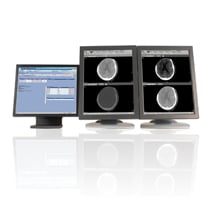
Report generation begins and ends in RIS.
For many hospitals, the next stage of PACS implementation involves integrating the radiology PACS with the cardiovascular image management system (CVIS). The integration enables the hospital to store all medical images in a single repository for improved image data management. In theory, integrating these two imaging silos can be seamless. In practice, this endeavor requires tremendous cooperation between the radiologists and the cardiologists. Not only must these two large departments share data and interface their systems, but agreeing on a common workflow, training staff and gaining physician buy-in is system critical to successful integration.
The first step is to design the architecture of the integrated network, the next is to identify a radiology PACS vendor that can meet the constructs of this design. When healthcare professionals from The Heart Hospital Baylor Plano (Plano,TX) set out to connect the heart hospital to radiology, they had to overcome not only technical challenges but workflow issues to ultimately streamline radiology and cardiology image retrieval and report generation.
The team of clinical and IT administrators at the heart hospital told their story in a Webcast entitled “Cardiology PACS Integration Can Be Seamless,” presented on Feb. 19, 2009, by Imaging Technology News, Diagnostic & Invasive Cardiology and OTech Inc. and sponsored by GE Healthcare.
The Webcast faculty included Christopher Oropeza, enterprise imaging administrator, Richard Sanders, RN, cath lab manager, and Lori Crissup, RN, cardiology IT specialist, The Heart Hospital Baylor Plano. President of OTech and well-known PACS consultant and trainer Herman Oosterwijk moderated the interviews.
Herman Oosterwijk (HO): Chris, what did the project entail?
Christopher Oropeza (CO): There was a seven-month timeline for the integration of 70 projects, 70 interfaces, eight that were new to the enterprise, and three implemented within a 90-day period. One implementation was a RIS, another a PACS and finally a CVIS.
HO: This was an example of a big bang approach to implementation. What were the challenges, and how did you get this accomplished?
CO: In an offsite location, we did our integration testing, building our interfaces, building our exam interfaces. For the PACS imaging servers, we have an EMC SAN CX300 connected directly to a HP. For our online storage, we have 6 Terabytes (T) and we’re currently using 2T, so we have 4T left for immediate image access. For our long term storage, we have EMC Centera with11 T and we’re utilizing about 2T of that. We are using 3 DAZ’s, which are DICOM acquisition servers for load balancing. So we have modalities sending to a particular DAZ. The DAZ is a gateway server.
HO: How do your radiology and cardiology information systems talk to each other?
CO: We gave a GE RIS ImageCast and a GE DMS, the data management system, which is where the cardiologists use structured reporting to confirm out the report. We have PowerScribe, which is what the radiologists use to interpret the radiology images. We also have a CVIS where cardiologists view the cardiology images.
HO: How are these systems interfaced?
CO: Our main hospital engine is Cloverleaf. Our RIS is IDX ConnectR, this is the broker. For the CVIS, we use Carddas. We generate two different worklists. Anything that is ordered for cardiology, like flouro, they pull from CVIS server. Anything that’s ordered for radiology, CT, vascular ultrasound, CR, is pulled from the radiology worklist.
HO: How do you make sure all of the patient information is identical between the two systems.
CO: All of that information is being fed from Cloverleaf, the ADT. And we have GE Centricity Enterprise, which is our HIS.
HO: Therefore, it is important to have a single source. So, how do you get the hemodynamics in there?
Richard Sanders (RS): The system that we elected to use is the GE MacLab Hemodynamics system and the CardioLab system for EP. There are times when you can create errors if you don’t have those ADT interfaces to bring the demographics over to the system on the front end. So the orders are placed in the RIS, and from the RIS the patient order is brought over on the schedule to the hemodynamic monitors. Once that patient is selected in the schedule on the monitor, we select the case and all of that information populates. And all of the hemodynamic data and all of the ACC data is transferred into the DMS servers. Then the cardiologist can go to the workstation in the cath lab and add his or her comments and results directly into the report.
Lori Crissup (LS): In the MacLab, they can enter information and there is mapping that populates the DMS side. So some of the information that is important in the final report comes from the MacLab. On the DMS side, they can complete the report and the mapping from the MacLab also populates our image system, so all the ADT feed flows there so that images are linked to our documentation. They can pull the images straight into the report. All of that can be confirmed off so that the report is automatically sent to their offices or to the referring physician at the same time. When the doctor confirms, the referring physician gets a fax.
HO: There are often problems with images from the OR being distributed as the surgeons tend to hold on to the images. What are some of the solutions you came up with in the OR?
CO: We are using the GE PACS Web and the physicians love it. We have several displays on the boom and a couple 50-inch flat screens mounted on the wall. The PACS image can be routed via the Admiral solution to the boom or to the wall.
RS: This is an endovascular lab and there is a MacLab hemodynamic monitor built into that room as well.
HO: What are some of the problems you experienced?
CO: Two of the main issues that I experienced, was the ADT orders and results were erroring out on the interface due to exam dictionaries not being in synch across multiple applications. There may be a character left off or an extra character, and if they are not built the same, it will not post in the receiver system.
The second thing was that the cardiology results not posing in the RIS and downstream systems due to a broken process. It’s still a work in progress.
HO: What would you have done differently?
CO: We could have had more stringent workflow testing and education with the cardiology staff because that is where the process was broken. The cardiology staff was not used to a radiology workflow, and we are using a RIS for cardiology, and if you do not follow that process of scheduling, arriving, beginning or completing the exam in RIS it could cause a break in downstream systems.
RS: Being that we started this hospital with a new hemodynamic system and the staff was brought over to use a different manufacturer’s hemodynamic system, it was a challenge getting them to use the new hemodynamic system and the RIS as well.
Some of the things we learned is that when we have mismatches, it made it more difficult getting the report completed at the end because if the order wasn’t there or if the patient wasn’t admitted correctly in the patient admit system, then we couldn’t even see the patient populated in the order system, and when that happens you have to plug in all of your data manually, and then it has to be cleaned up on the backend. That prevents the physician from completing his report because it all has to be correct before the report gets completed.
We need to make sure that on the hemodynamic system is inputting all of the data we need in regards to what procedures were done, and all of those are linked for billing.
HO: Workflow and training are extremely important. What’s your approach?
RS: We are working with a group of physicians who were used to dictating all their reports. Now they have to interface with the computer and learn the software to be able to input the data that they used to dictate in three or four minutes. Once they see how they can create really good quality reports, they see the benefits when sending out to referring physicians, especially with the images input into the report.
HO: How do you deal with the physicians’ likes and dislikes?
CO: I run an audit within the RIS and you can run a report on reports that have not been resulted out, and I will compare that to what DMS has, the structured reporting, and if there is something confirmed there, but not confirmed in RIS. Then I have to go into the interface, replay that result message from DMS, which causes the results to go into the RIS and then flow down Centricity Enterprise and the EMR portal.
HO: What is the most frequent problem you have to fix?
RS: On a daily basis, I go into the DMS database and I do case resolution. What that does is puts the types of cases in the correct buckets in the database, and it makes sure my procedure charges and supply charges are in the correct bucket – diagnostic or interventional procedures. With this database we use crystal reporting – a database query software – to do customize reports. On a monthly basis, our hospital administration looks at how many cases each physician does, how many PCIs, how many diagnostic peripheral vascular cases are done.
HO: How do you deal with password issues – do they remember them or lose them?
LS: In our Centricity system there is only one password. The user i.d. is used enterprisewide and is the same for every system they get into. In our Centricity we have one password that doesn’t change so they keep track of that password and that allows them to get into their own reports and confirmation privileges are set up so they can confirm their reports. The physician just needs information from the DMS system because all the hemodynamic information comes from the other systems.
HO: Did you have a problem with synchronizing different passwords with different systems?
CO: The user name stayed the same for the whole system – when they enter the hospital and for the PACS and RIS.
HO: Do you have a single or multiple image storage? How can a physician see the images from both radiology and cardiology?
CO: What’s unique about this hospital is we have one central repository for both radiology and cardiology images. They all are pushed and stored in one central location.
HO: Are there two worklists?
CO: When they walk up to that workstation, it pulls that folder whether its radiology or cardiology – it’s tied to one number. Something that is somewhat unique to our hospital is that after a cath case or EP case, the patient is pushed back to the suite and the physician goes over the case. In the room there is a 36-inch screen that is utilized via the PACS web.
HO: Are there any lessons learned or something you would do differently the next time around?
CO: One was regarding having the password equal across multiple applications. The second was the stringent RIS workflow testing with the cardiology staff, and allow for more rounds of testing with longer duration of each round.
RS: The toughest part about the whole start-up was getting the physicians on board with the reporting. In the future, I would require more training for the physicians. One of things the physicians want, and we are looking forward to having it, is Web-based access so the physicians do their confirmation remotely.
LS: Many physicians don’t only work at this hospital, so they need staff available at all times to assist them with technical questions.



 November 29, 2025
November 29, 2025 









